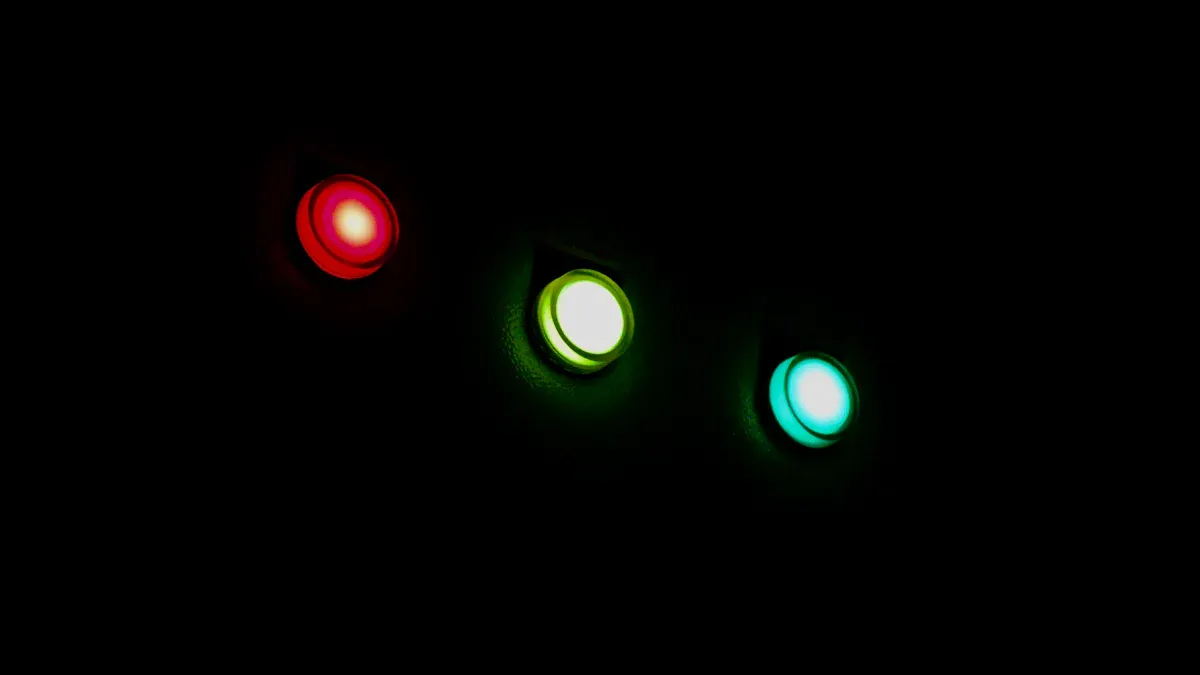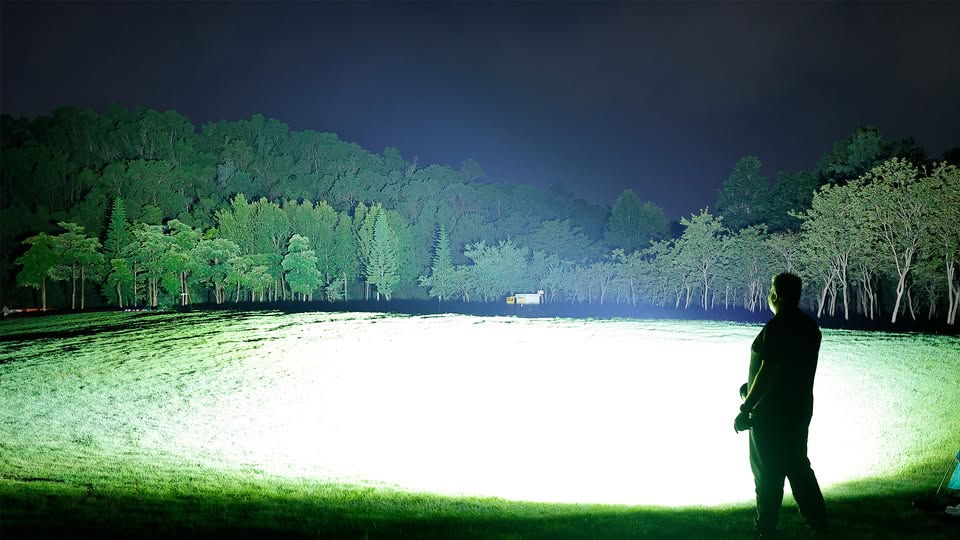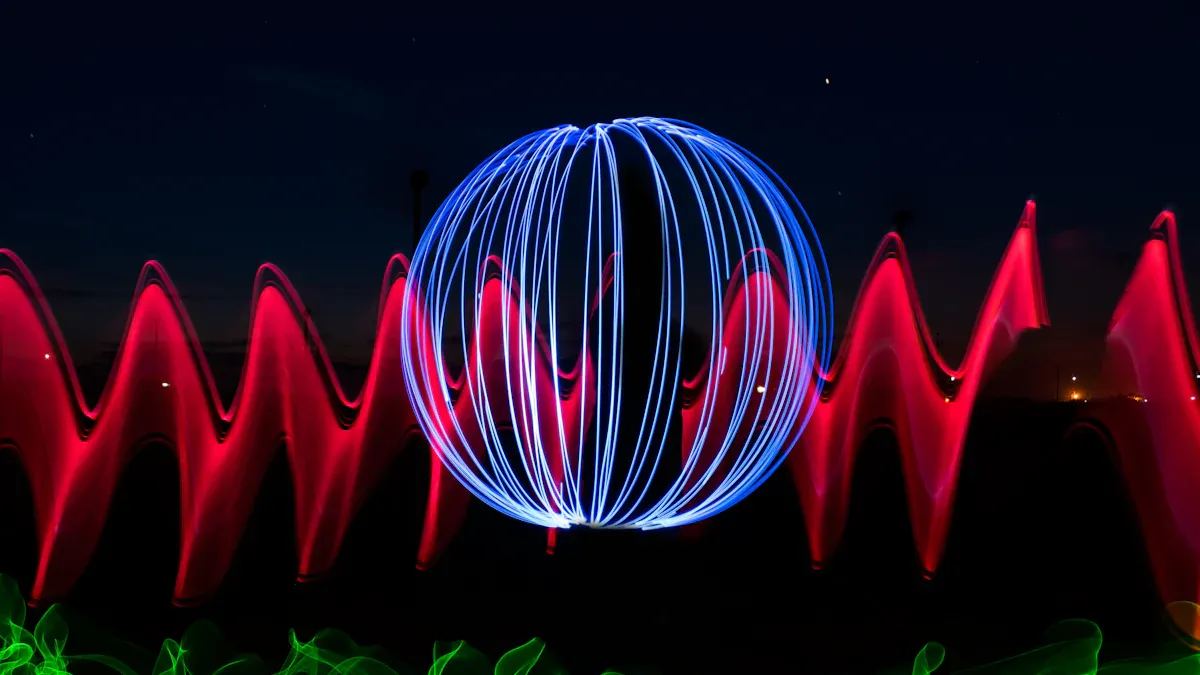White vs. Red vs. Green Flashlight Beams: Which Is Right for You?

You want the right flashlight for every situation. White beams give you unmatched versatility for scanning, navigation, and general use. Many flashlights use white light because it helps in initial search and advance. When you need to protect your night vision, a red light flashlight works best. Hunters and wildlife observers use red beams to check gear or spot animals at night. For long-distance spotting, green beams on flashlights provide a clearer view and longer range than other colors. Green beams also excel in open fields at night.
Experts recommend white flashlight beams for scanning, red for stealth and preserving your night vision, and green for spotting at night over long distances.
Think about your activities before you select a flashlight. Your needs should guide your choice, whether you want flashlights for night navigation, hunting, or scanning wide areas. The right flashlight helps you stay safe and effective at night.
Key Takeaways
White beams provide the brightest light, making them ideal for general navigation and emergency situations.
Red beams preserve your night vision, making them perfect for stealth activities like hunting and astronomy.
Green beams excel at long-distance visibility, helping you spot objects or wildlife in low-light conditions.
White Beam

Brightness
White beam flashlights deliver powerful illumination that you can rely on in almost any situation. You get a clear, bright view whether you are indoors or outdoors. The brightness of a white beam often matches or exceeds common household lights. For example:
Light Source | Lumens |
|---|---|
60-watt incandescent bulb | 800 |
100-watt incandescent bulb | 1600 |
1200-lumen flashlight | 1200 |
A 1200-lumen flashlight provides enough light for daily activities inside your home and for outdoor adventures like camping or hiking. The intensity of the beam can feel different depending on your surroundings. In a dark area, the light appears more intense, while in a well-lit room, it blends in. The beam angle also matters. A narrow beam creates a focused spotlight, while a wide beam spreads light over a larger area.
Everyday Use
You will find white beam flashlights useful for many daily tasks. They help you see clearly and stay safe in low-light conditions. Here are some common uses:
Everyday Use | Description |
|---|---|
Walking the dog | Ideal for illuminating dark paths during evening walks. |
Navigating dark areas | Provides sufficient brightness for safely moving through poorly lit spaces. |
Useful for various tasks around the house, such as finding items or repairs. |
White beams work well for general navigation, emergency situations, and even as weapon lights. You can depend on them for both indoor and outdoor needs.
Limitations
White beam flashlights have a few drawbacks you should consider:
High-quality tactical models can cost over $200.
You need batteries, and if they run out, your flashlight will not work unless you have spares.
You may also find that white beams can disrupt your night vision or draw attention in tactical situations. For most general uses, though, white beams remain the most versatile choice.
Red Light Flashlight
Night Vision
You need a red light flashlight when you want to protect your night vision feature. Red light preserves your eyes’ sensitivity in the dark. This makes it a top choice for astronomy, wildlife observation, and stealth night hunting. Scientific studies show that red light has less impact on your visual sensitivity than green or white beams. Green and white lights activate the rods in your retina, which can ruin your night vision feature. Red light, however, lets you see in low-light conditions without losing your night-adapted vision. You will find this especially helpful if you use night vision technology or need to read maps at night.
Red light conserves your night vision feature, making it ideal for wildlife observation and astronomy.
Red light flashlight beams do not activate rod cells in your eyes, so you keep your night vision feature longer.
The military uses red light to preserve night vision technology and reduce visibility to enemies.
Stealth
Stealth is critical for successful night hunting, tactical operations, and wildlife observation. Red light flashlight beams help you move quietly and remain unnoticed. Animals see red light less easily, so you can get closer without startling them. The best flashlight color for stealth hunting is often red, especially when you want to avoid detection. Many hunters and soldiers rely on red light for stealth because it provides enough visibility while keeping a low profile.
Evidence Type | Description |
|---|---|
Preservation of Night Vision | Red light minimizes disruption to night vision, allowing users to see better in low-light conditions. |
Military Use | Soldiers use red light for navigation and communication at night, maintaining stealth during operations. |
Hunting | Hunters benefit from red light as it disturbs wildlife less, aiding in remaining undetected. |
Stealth Operations | Red light provides visibility while keeping a low profile, essential for covert missions. |
You should choose a red light flashlight if you want the best flashlight color for hog hunting or need to stay hidden during stealth operations.
Drawbacks
Red light flashlight beams have some limitations. You may notice that red light does not illuminate as far as white or green beams. This can make it harder to spot objects at a distance. Some users find it difficult to read colored maps or see fine details with red light. If you need a hunting flashlight color for long-range spotting, green might work better. Still, for stealth and preserving your night vision feature, red remains the top choice. Always match your hunting flashlight color to your main activity for the best results.
Green Beam
Visibility
You will notice that green beam flashlights and headlamps stand out when you need to see better in low-light. The human eye responds more efficiently to green light than to other colors. This means you can see objects more clearly with green beams, even if the lumen count matches other colors. When you use green flashlights and headlamps in low-light conditions, you gain a brighter and sharper view. Many outdoor enthusiasts choose green headlamps for hiking or camping because they help you spot details that might go unnoticed with other beams.
The human eye is more sensitive to green light than any other color, making it appear brighter for the same lumen count.
Green light is perceived more efficiently by the human eye under low-light conditions, making it ideal for activities like hiking and hunting.
Long Distance
Green flashlights and headlamps excel at long-distance spotting. You can rely on them to illuminate targets or objects far away, especially in open fields or forests. Many hunters and tactical users prefer green beams for this reason. Manufacturers often design green LEDs to throw light farther than red or white. The table below shows how green compares to other beam colors for maximum distance:
Beam Color | Max Beam Distance |
|---|---|
Green | 820m |
Red | 1,400m |
White | N/A |
You will find that green flashlights and headlamps help you identify animals or landmarks at a distance in low-light conditions. This makes them a top choice for hunting, search and rescue, and tactical operations.
Downsides
Green flashlights and headlamps do have some drawbacks. You may notice that green beams can be too bright for close-up tasks in low-light. Some users find that green light can disturb wildlife more than red, especially in sensitive environments. Green headlamps may also cause eye fatigue if you use them for extended periods in low-light conditions. For general navigation or reading maps, you might prefer red or white beams. Always match your choice of flashlights and headlamps to your main activity and the specific low-light conditions you face.
Beam Comparison

Differences
When you compare flashlight beams, you notice clear differences in performance, efficiency, and environmental impact. Each color offers unique strengths for specific tasks. You should consider these factors before making your choice.
Beam Color | Brightness & Visibility | Night Vision Impact | Energy Efficiency (lm/W) | Battery Life | Environmental Impact |
|---|---|---|---|---|---|
White | Brightest, wide coverage | Reduces night vision | 20% | Shorter than red | Low (LED), no mercury |
Red | Lower brightness, soft glow | Preserves night vision | 35% | Longer than white | Low (LED), no mercury |
Green | High visibility, sharp detail | Mild impact on night vision | Not detailed | Not compared directly | Low (LED), no mercury |
You see that white beams provide the most illumination. Red beams protect your night vision and use less power. Green beams offer excellent visibility and help you spot objects at a distance. Most modern flashlights use LED technology, which reduces environmental impact and avoids hazardous materials like mercury.
Tip: If you want to maximize battery life, choose a red beam. If you need the brightest light, select white. For spotting details in the dark, green beams work best.
Recent advancements in flashlight technology have expanded your options. Manufacturers now offer beams in blue, yellow, and ultraviolet, each with specialized benefits. For example, blue light enhances detail for map reading, while yellow light helps you distinguish colors at night. However, white, red, and green remain the most popular choices for outdoor and tactical use.
Best Uses
You should match your flashlight beam color to your main activity. Each color excels in different situations. Here is a quick reference table to help you decide:
Beam Color | Best For | Practical Benefits | Common Applications |
|---|---|---|---|
White | General navigation, emergencies | Bright, wide coverage, easy to use | Home, camping, search & rescue |
Red | Night vision, stealth, astronomy | Preserves night vision, less visible to animals | Hunting, stargazing, military |
Green | Long-distance spotting, detail | High visibility, less disturbance to wildlife | Hunting, hiking, tactical |
Use a white beam when you need to light up a large area or perform tasks that require maximum brightness.
Choose a red beam for activities that demand stealth or when you want to keep your eyes adjusted to the dark.
Select a green beam for spotting animals or objects at a distance, especially in open fields or forests.
You may also want to consider the environmental impact of your flashlight. LED flashlights with red or green light use less energy and last longer than older incandescent models. This means you can reduce waste and save on battery costs over time.
Note: Always assess your environment and activity before choosing a beam color. The right choice improves your safety and efficiency outdoors.
Choosing Your Beam
Assess Needs
Selecting the right flashlight beam starts with understanding your specific requirements. You should ask yourself what you want to accomplish with your flashlight. Different situations call for different beam colors, so a careful assessment helps you make the best choice. Consider these key factors:
Purpose of the flashlight: Define your main use. Are you planning to hunt, camp, hike, or respond to emergencies? Each activity benefits from a different beam color.
Environment: Think about where you will use your flashlight. Dense forests, open fields, and urban settings all affect how well a beam performs.
Personal preferences: Your comfort matters. Some people prefer the softer glow of red light, while others like the sharpness of green. Aesthetic choices can also influence your satisfaction.
Tip: Write down your top priorities before shopping. This step helps you avoid impulse buys and ensures you get a flashlight that truly fits your needs.
Activity Match
Matching your beam color to your activity ensures you get the most out of your flashlight. The table below shows how different beam colors perform in common outdoor scenarios:
| Beam Color --- | Activity --- | Advantages --- | | Red --- | Camping, Hunting --- | Maintains night vision, stealthy, less visible to animals --- | | Green --- | Hiking, Hunting, Emergency Response --- | Better visibility in low light, penetrates fog and smoke --- | | Blue --- | Navigation, Detail Work --- | Improves visual acuity and contrast for tasks requiring attention to detail --- |
If you want to know how to choose the right hunting flashlight, focus on your main hunting environment and the type of game you pursue. Red beams work well for stealth and preserving night vision, while green beams help you spot animals at a distance. For hiking or emergency response, green or white beams provide the visibility you need.
Note: The best hunting flashlight choices often combine multiple beam colors or offer interchangeable filters. This flexibility allows you to adapt to changing conditions in the field.
Decision Tips
You should also consider durability and warranty when making your final decision. Reliable brands offer strong support and repair options, which can save you time and money if your flashlight needs service. The table below highlights warranty details from leading manufacturers:
| Manufacturer --- | Warranty Duration --- | Repair Process --- | | Streamlight --- | 6 months to limited lifetime --- | Authorized Repair Centers available --- | | Maglite --- | 6 months to limited lifetime --- | Authorized Repair Centers available --- | | Princeton Tec --- | 6 months to limited lifetime --- | Send to factory for repair/replacement --- | | Underwater Kinetics --- | 6 months to limited lifetime --- | Send to factory for repair/replacement --- | | Fenix --- | Varies --- | Warranty through distributor --- | | Nitecore --- | Varies --- | Warranty through distributor --- |
When you compare models, check the warranty terms and the ease of getting repairs. A good warranty adds peace of mind, especially if you use your flashlight in tough environments.
Pro Tip: Always test your flashlight before heading out. Make sure the beam color, brightness, and controls meet your expectations. Carry spare batteries or a backup light for added security.
Choosing the right beam color is not just about brightness. It is about matching your needs, activities, and environment. Take your time, compare your options, and select a flashlight that will serve you well in every situation.
Flashlight Beam Color | Strengths | Weaknesses |
|---|---|---|
White | Suitable for weapon lights and illuminating environments | Detracts from natural night vision |
Red | Less impact on night vision, provides great contrast | N/A |
Green | Soft light, less disturbance to animals and insects | Disturbs natural night vision more than red light |
Choose a beam that matches your main activity.
Prioritize safety and visibility for maximum effectiveness.
Enjoy your outdoor adventures with the right flashlight beam for every situation.
FAQ
What is the best flashlight beam color for camping?
You should use a white beam for general tasks. Red beams work well for preserving night vision around camp. Green beams help you spot wildlife at a distance.
Can animals see red or green flashlight beams?
Most animals see red light poorly, so you stay less visible. Many animals detect green light more easily, which can alert them to your presence.
Do colored flashlight beams affect battery life?
Red and green beams often use less power than white. You may notice longer battery life when using colored beams, especially with LED flashlights.
See Also
Comparing Police Flashlights And Standard Flashlights: A Guide
Green Light Flashlights Versus White Light: A Hunting Comparison
Selecting The Best Color Flashlight For Outdoor Adventures
Zoomable Flashlights Or Reflector Caps: Finding Your Best Fit
